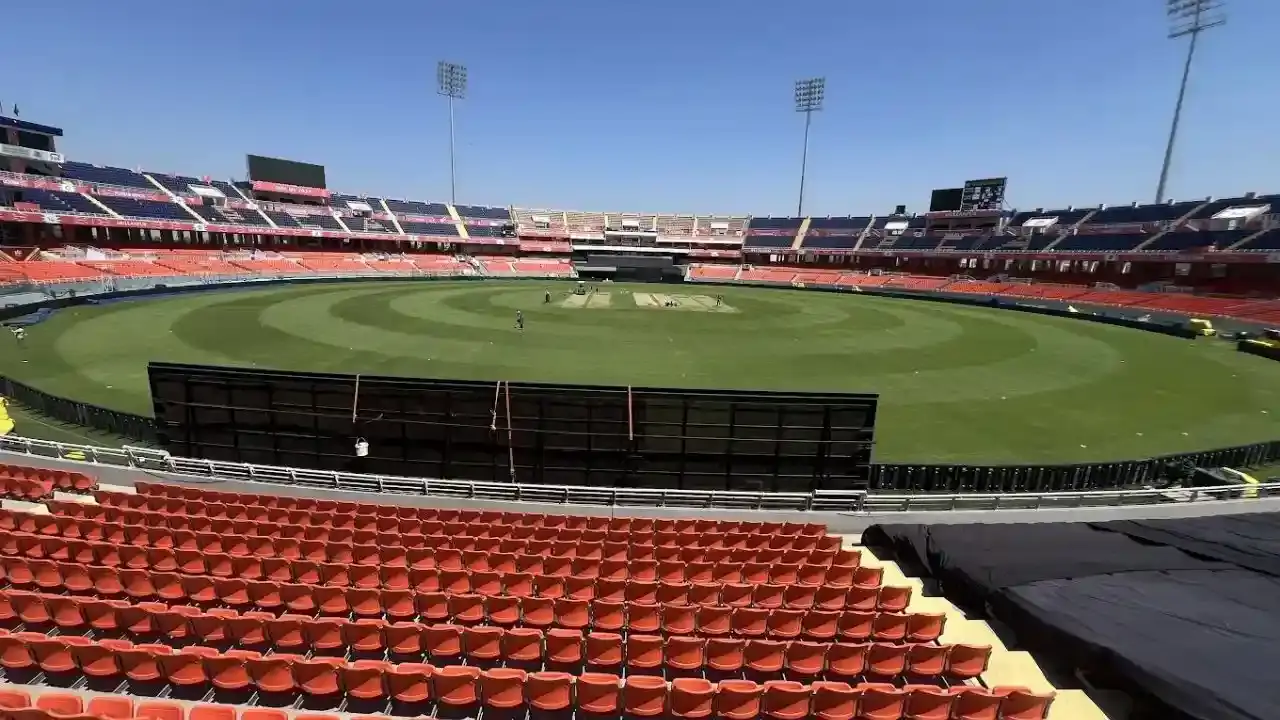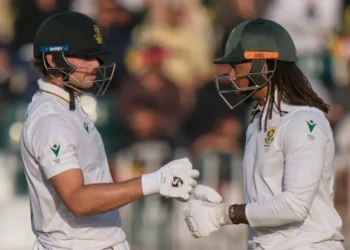India arrive in Guwahati with many questions and rising tension. The defeat in Kolkata exposed problems that hurt both morale and planning. That pitch broke early and created conditions no side correctly expected. India now hope Guwahati delivers a surface that finally behaves normally.
Barsapara offers a red-soil wicket with an even cover of grass right now. Curators watered the pitch recently and may trim the grass before play begins. These details matter because minor changes decide how much help seamers find early. That same preparation also shapes how spinners operate from day three onwards.
The coaching group admitted Kolkata went wrong from day two itself. They insisted no one wanted a crumbling surface that behaved strangely. Their goal remains simple and consistent across venues in India. They want a pitch that lasts four days and rewards spin-friendly control late.
Guwahati forces another new variable due to its eastern location. Play starts at 9am because daylight fades early at this venue. Morning moisture may help new-ball bowlers use early seam movement more effectively. Evening light may fade earlier and shorten the final session often.
How the Red-Soil Pitch Shapes Bounce and Early Movement?
Red-soil bases often produce higher bounce that lasts across early sessions. This bounce depends on how much moisture sits below the trimmed grass layer. A slightly firm surface allows the ball to carry cleanly to the keeper. That helps both teams use the new ball with good control.
Barsapara currently shows an even grass cover that influences early behaviour. Curators may reduce the grass to support balanced batting conditions. A reduced layer means less sideways movement off the surface for seamers. But it still supports controlled bounce that tests defensive methods.
The team wants no repeat of the Kolkata collapse that came too soon. They hope the underlayer at Barsapara remains stable across early overs. A stable underlayer avoids the top surface cracking prematurely. That balance reduces the chance of unplayable balls appearing before day three.
Moisture distribution decides how quickly spinners enter the contest here. Too much dryness in the top layer makes the ball grip earlier than expected. That early grip may create a sharp turn that hurts rhythm and planning. India trusts that curators will maintain a surface that behaves predictably.
Why Red Soil Supports Balanced Bowling Through Multiple Sessions?
Red-soil structure drains water quicker than typical clay-based surfaces. This faster drainage helps seamers early when morning dampness remains. That dampness creates soft seam interaction that moves naturally off the wicket. Batters need tight technique to counter those first overs.
As sun intensifies, the top firms and rewards disciplined spinners later.
This later firmness helps spinners attack with steady drift and subtle dip. Batters must read the angle closely when movement appears across day three. Red soil therefore supports both bowling types without sudden extremes.
Why India Want Measured Turn and a Four-Day Contest?
India prefer controlled turn starting from late day two or early day three. Controlled turn allows their spinners to apply pressure in longer spells. It avoids unfair conditions that destroy batting confidence too soon. It also supports strategic decisions across morning and evening sessions.
Coaches recently clarified the Kolkata pitch was not requested by the team. They stressed their ideal pitch never breaks on day one or day two. Their main priority remains maintaining late spin support through natural wear. That spin support gives India an advantage without making contests one-sided.
A four-day match aligns with India’s usual home Test demands and plans. It gives batters enough time to post strong totals under low pressure. It lets bowlers operate in cycles based on pitch evolution across days. It ensures tactical battles remain genuine without random outcomes.
India want Guwahati to recover their rhythm after a difficult loss. They expect the surface to provide bounce early and turn late. They hope this will rebuild confidence in their home conditions. That confidence helps them approach the rest of the series comfortably.
How Measured Turn Helps India Control Match Rhythm?
Measured turn lets bowlers attack batters without unpredictable explosions. It gives them time to vary their flight and loop across long spells. These variations matter because red soil reacts to slower bowling changes. Batters then must take calculated risks to avoid being struck safely. With measured turns, captains can set attacking catching fields more confidently. Those fields make wicket-taking pressure consistent without feeling forced.
Seamers’ Window: Morning Moisture and Early Carry
Guwahati’s 9am start shifts the seaming window into an earlier period. Morning moisture survives longer before sunlight evaporates it naturally. That moisture creates fresh seam deviation that threatens both edges. Batters must watch the ball closely to avoid early mistakes.
Pace bowlers may enjoy controlled carry that suits chest-high movement shots. This carry helps them push batters onto the back foot comfortably. It also tempts batters into risky drives through uncertain channels. Those risks often decide whether a team dominates the first session.
Weather adds a second layer of complexity to the seaming phase. Early cloud cover influences how much swing appears in the opening overs. Cloud cover also reduces surface heat that might dry the pitch earlier. That delay keeps bowlers interested for longer spell durations.
Captains must rotate their seamers carefully during this early window. Long spells can reduce accuracy when conditions favour fresh movement. Short bursts with aggressive fields protect bowlers from fatigue. This strategy builds maximum pressure during helpful conditions.
Adjusting Seam Lengths and Field Settings in Guwahati
Seamers usually target fuller lengths when moisture is visible early. Fuller lengths encourage natural nip that troubles uncertain footwork decisions. When the bounce increases, they adjust shorter to push batters back. Fields must include slip catchers ready for deviation off the shiny seam.
These small adjustments amplify the wicket-taking potential of the first hour. Timing these adjustments correctly changes match control quickly.
Spin Prospects After Day Two and the Growing Rough
Spin becomes significant at Barsapara once the top layer firms. Firm surfaces create friction for steeper spin angles through the middle overs. Spinners use that turn to set up dismissals with subtle pace variation. Batters facing these spells must trust their technique and play late.
Day three usually becomes the point where turn grows naturally. Sunlight dries the top and exposes minor cracks across good lengths. Those cracks generate small but effective turn for skilled bowlers. That turn becomes gradual pressure that shapes partnerships slowly.
Teams must judge whether the wicket becomes too dry too early. Excess dryness replicates Kolkata’s unwanted behaviour that hurt match quality. Balanced dryness ensures India’s spinners dominate without creating chaos. That balance helps both sides play honest cricket based on skill.
Spinners must also consider the angle from which they attack batters. Around-the-wicket lines exploit rough formed by pace bowlers’ footmarks. That rough grows across the match and supports deeper turn.
Flight, Trajectory and Strike Zones for Successful Spells
Spinners should build rhythm with modest flight during early spells. Modest flight helps them read drift patterns before increasing variation. Later, they can introduce steeper trajectory when turn strengthens. Batters then must defend different strike zones across each over. Small changes in release angle create confusion inside a batter’s judgment. That confusion increases dismissal chances as rough expands on day three.
Light, Weather and Match Scenarios Shaped by Eastern Timing
Guwahati sits east compared to most major Indian venues. Daylight fades earlier here than in other Test locations. This creates reduced evening windows that may end sessions early. Captains must prepare for shortened final spells across most days.
Bad light may force umpires to stop play before the scheduled time. That limits bowlers who prefer evening shadows during long spells. It also reduces the possibility of late breakthroughs in tough sessions. Those breakthroughs often come when batters lose focus under fading light.
The early 9am start offsets some of the evening loss in time. But it also means batters face tricky moisture within the first hour. That moisture often decides whether a team collapses or survives. Teams must warm up early to avoid slow starts on such mornings.
Possible match outcomes depend heavily on how fast the wicket evolves. A balanced surface encourages a four-day or five-day contest. But unexpected dryness may create a three-day finish like Kolkata. Both teams remain cautious because timing influences every session.
Managing Overs, Declarations and Review Timing Wisely
Captains must avoid slow rates that reduce precious daylight. Consistent over speeds create room for controlled declarations later. Declarations matter because shrinking evening periods punish slow scoring. Teams should use reviews wisely when time narrows late in the day.
These tactical details guide final outcomes when light becomes unpredictable.
Conclusion
Guwahati offers India a chance to reset after a chaotic week. The surface promises bounce early and measured turn later. Seamers may enjoy helpful conditions during the 9am starts here. Spinners should become threatening once the top layer dries gently.
India hope this pitch avoids the mistakes of the previous Test. They want a fair contest that lasts four or five days comfortably. They also want conditions that reward skill-based control rather than randomness. Their plan relies on maintaining trust between coaches and curators.
Morning sessions may shape the rhythm of this entire match quickly. If early moisture creates movement, batters must adapt immediately. Evenings may end early because shadows arrive faster in Guwahati. Those early endings may protect batters from dangerous late spells.
A balanced wicket will allow both teams to showcase their strengths. Seamers can attack edges with new-ball accuracy across the first hour. Spinners will apply pressure once natural wear shapes the surface. The match should progress smoothly unless unexpected dryness appears suddenly.
This Test becomes a critical moment for India’s home reputation again. A stable Guwahati pitch can restore calm after Eden Gardens. A misbehaving surface may spark new criticism across formats. Both teams therefore watch every change in preparation with careful attention.














